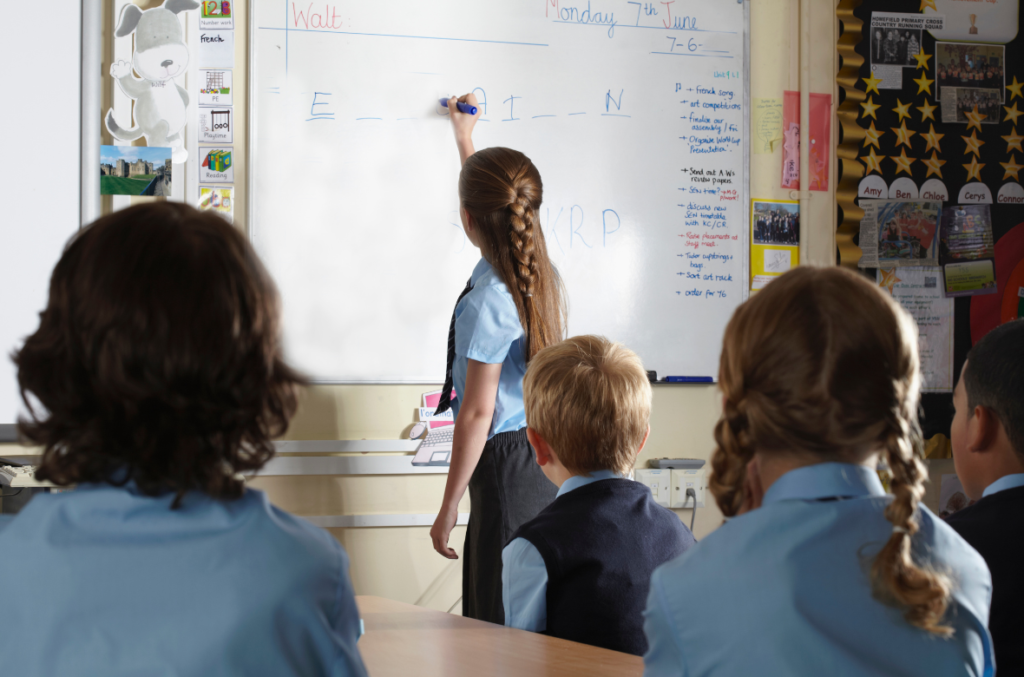Ways to Increase Student Memory Power
Every teacher knows the sheer joy that students take in becoming experts on their favorite topics! From dinosaurs to planets and everything in between, if they are interested, they have a remarkable ability to retain and remember a huge amount of information.
What if we could harness this enthusiasm to encourage this type of interest and memory power in other school topics?
Let me tell you about one of my favorite memory exercises I did regularly in my kindergarten class using whiteboards! I talked this activity up as a reward, a fun learning game, and a responsible, big-kid way to show what we know.
First, we all sat together as a group on our gathering rug, and each student got a mini whiteboard, a whiteboard marker, and an eraser. Then, I verbally asked them questions about what they had been learning. The students wrote the answers to the questions on the boards and held them up to show what they knew.
When you do this exercise, you can see who is participating and understanding and can provide immediate feedback. It easily involves all the students at the same time, so it’s incredibly efficient for collecting data.
I used this activity to have my students practice their letters, write sight words and vocabulary words, show their work for math problems, answer story problems, sound out words, practice sentence structure, and so much more! The kids loved it and asked for it often. Really truly!

I recently read a wonderful book on cognitive research about how students learn and remember information. Our understanding of how we learn has never been greater, and it is so important to know how to apply and implement strategies that help boost students’ retention and recall.
I love sharing information that I feel can benefit teachers and help students succeed. So, I want to share some practical ideas Kate Jones shares in her book, Retrieval Practice: A Guide for Primary Teachers and Leaders, that can help bridge the gap between research and work in the classroom.
In her book, Jones explains that students should practice strategies that increase memory power throughout the year and not just during testing time. Students can learn that our memories are marvelous, and they can get excited about increasing their capabilities. Practicing memory-boosting strategies during lessons, rather than cramming or drilling and grilling right before an exam, can help reduce anxiety and build students’ confidence in what they truly know.
Regular review and reflection are key! The more children practice recalling information from memory, the easier it will be to recall that information in the future.
As teachers, we can arm our students with strategies to help them focus on what they are learning, recognize what is already in their memory, and identify what they need to work on remembering. We help our students take ownership of their learning when we teach fun, engaging, and versatile strategies to help strengthen the power of their memories.
In addition to quizzes, verbal recall activities, or writing from memory, students also practice exercising their memories when they work with partners to share work, compare answers, and teach the class. Testing can also help you benchmark how well your students remember the material and show you gaps in their knowledge.
These types of activities, games, and tasks can also be very rewarding in other ways! They can do wonders to promote communication, collaboration, and connection within a class as students help each other and work together toward becoming retention and recall experts.
Here are 5 fun ideas Kate Jones also recommends in her book to increase memory power:
1. Cops and Robbers
On a piece of paper, write “Cops” on one side and “Robbers” on the other side with a line down the middle.
Under “Cops,” students are to stretch their memories to write all they can about a specific topic they have learned in class in a set amount of time. This is like brainstorming or a brain dump, where they remember everything they can on the covered topic.
Then, students will check another student’s paper to see what they wrote under their “Cops” side and will “steal” any information they might have missed by adding it to the “Robbers” side of their own paper.
This is swapping and sharing ideas and content at its best! Teaching one another is powerful.
2. Individual Spotlight
Like using an anchor chart, this activity works great for helping students remember details about people or characters from stories.
First, put the person’s or character’s name and picture on the board or on chart paper. Students are then to focus on key aspects of the individual and write them down all around the name/picture. This exercise encourages more specific and focused retrieval and helps their memories to be more precise.
Jones explains that you can also add other people or characters to the board to help students work on remembering connections between them. This can help you further the discussion and deepen their thinking!

3. Retrieval Pyramid
For this activity, choose questions about what you have covered in class with varying levels of difficulty. Put the easier questions on the bottom of the pyramid, so the students can start off with a boost of confidence. As you go up the pyramid, the questions should get more challenging.
This idea is played like a game, so it should help students exercise their memories without stress.
4. Relay Race
This relay race doesn’t need to be saved for recess because students will exercise only their minds and memories. For this memory-boosting activity, divide a piece of paper for each student into 4 boxes.
In the first box, students must write as much as they can remember about a topic. Then, students should pass their paper to a friend or neighbor and read their answers. They then add everything they recall in the second box of their friend’s paper without repeating any of the information written in the first box. Make sure to give them plenty of time to read their neighbor’s answers and to add their own.
The papers are then passed to another neighbor, where a third friend writes as much non-repeating information as they can in the third box. The rules continue in this pattern for the last box.
This game helps students stretch their memories while also collaborating with others!
5. Retrieval Tennis game
In this memory activity, students work with a partner to take turns recalling facts and information relevant to the given review topic. They take turns adding facts and statements from memory without repeating any information that has already been said.
You can add to the fun with a real tennis ball for them to toss and catch on their turns! If a real ball is too distracting or not available, a picture of a tennis ball to push back and forth between partners could also work. You can also add scorecards if you wish.
I hope these ideas spark interest in trying something new. I highly recommend reading more about retrieval practice and how to help your students improve their memories in Kate Jones’ books.
I love hearing what experiences work for you! What recall strategies do you enjoy using with your students?
I am convinced that learning from one another is the best way to support our students in their learning. Keep up the amazing work you are doing!
Warmly,
Debbie
